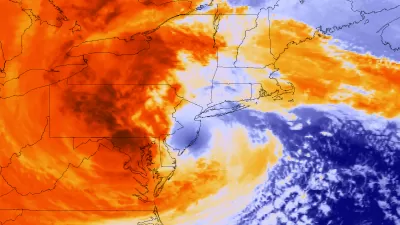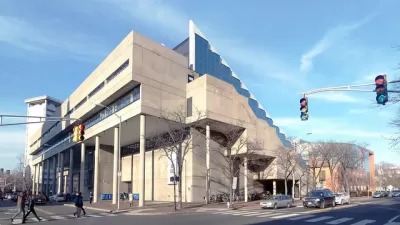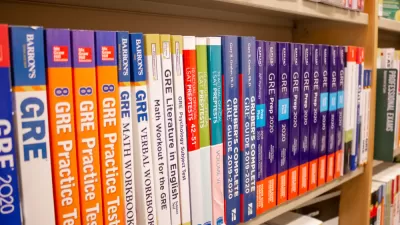Exclusives
BLOG POST
From Sparks of Brilliance to Waves of Reform
Bottom-up urbanism, now becoming increasingly popular in the academy under the rubrics of “do-it-yourself (DIY) urbanism”; “guerilla urbanism”; “tactical urbanism” etc., are the surest sparks of brilliance and hope for our urban future.

FEATURE
Planetizen's Responsive Redesign
We have completely redesigned and rebuilt the Planetizen website. Enjoy the new features, a fresh new look, and a streamlined mobile-friendly design that's optimized for your laptop, tablet, and smartphone.

FEATURE
Back To The Future: The 1970 Los Angeles 'Centers' Concept Plan
The 1970 Concept Los Angeles plan is a history lesson for urban planners and a vision of what the city could have looked like.
BLOG POST
Greetings from Manila
Greetings from Manila where I'm attending the Asian Development Bank's Transport Forum 2012. It is an exciting and important event: the types of transport planning investments that the bank supports now can have huge impacts on the nature of future.

FEATURE
Jail the Planners for Not Preventing Sandy!
Ed Blakely indicts the planning profession for failing to protect our communities from the threat of a changing climate. How can we plan places that serve as bulwarks from the worst physical traumas, while providing economic and social resiliency?
BLOG POST
Shared Hardship and the Souls of Cities
I can't remember the last time I left the house and gave a moment's though to whether I'd be warm enough, or whether I needed to bring an umbrella. Meanwhile, half the East Coast is underwater right now.

FEATURE
Planning Education: Striking a Better Balance
Planning education and practice fail to recognize the importance of physical design and spatial planning. Randall Arendt diagnoses the root of the disorder and suggests some treatments for returning urban planning to good health.

BLOG POST
Does it Make a Difference if a Planning Program is in a Policy, Design, or Other Kind of School?
Students investigating options often ask if it makes a difference where the planning school is located. The short answer is it matters less to students than many think.
BLOG POST
How to Turn One Disaster Into Two
In St Bernard Parish, it took almost 7 months for the crickets and other insects to return after Katrina. In that period there was silence at night to go with the darkness.<br /> <br /> But the first plans for recovery were delivered inside a mere 80 days, during which time none of the people were talked with or listened to except for the wham bam ty m'amisms that are the lifeblood of the charrette. <br /> <br /> Is it any wonder there are two disasters to recover from a full seven years later? The first a storm. The second, an imposition.<br />
BLOG POST
The Not-So-Libertarian Argument For Sprawl
<p> In the 1990s, most public argument about suburban expansion was pretty simple. Environmentalists argued that sprawl increased pollution, while their opponents responded by invoking the free market. Environmentalists and other sprawl critics (including myself) responded that sprawl is the result less of the free market than of <a href="http://works.bepress.com/lewyn/28/">government subsidy and regulation</a>. </p> <p> Recently I have started to notice hints of a not-so-libertarian argument for sprawl: that pro-sprawl government policies such as highway construction open up real estate for development, and thus make housing affordable. </p>
BLOG POST
Enough with Bikes vs Cars – It’s about Better Cities!
<p> A few weeks back, I watched with concern Toronto having a rhetoric-heavy debate about removing the relatively new bike-lane on Jarvis Street. Last minute efforts to save the bike-lane <a href="http://www.thestar.com/news/gta/cityhallpolitics/article/1265847--jarvis-bike-lanes-to-be-removed-after-last-ditch-council-effort-to-save-them-fails" target="_blank">were ultimately unsuccessful</a>, although as small consolation, Council chose not to use bike-lane infrastructure funds to remove it – a previous intention that had been seen as adding budgeting insult to active mobility injury.<br /> <br />
BLOG POST
Share Your Ideas for Evaluating Transport System Performance
<p class="MsoNormal"> <a href="http://www.dot.gov/map21">Moving Ahead for Progress in the 21st Century (MAP-21)</a>, the new U.S. federal transportation law, has the following main goals: </p> <ol style="margin-top: 0cm"> <li class="MsoNormal">Safety</li> <li class="MsoNormal">Infrastructure condition</li> <li class="MsoNormal">Congestion reduction</li> <li class="MsoNormal">System reliability</li> <li class="MsoNormal">Freight movement and economic vitality</li> <li class="MsoNormal">Environmental sustainability</li> <li class="MsoNormal">Reduced project delivery delays</li> </ol> <p class="MsoNormal"> </p>

BLOG POST
How Much do GREs Matter for Graduate School in Planning?
If you are applying to graduate school in planning, how much do GREs matter? Like many things in planning the answer varies with the person and program. Below I provide some general advice.
BLOG POST
Designing Public Spaces That Serve Users, Rather Than Egos
<p> These are heady times for public space advocates. At long last the promotion of streets, sidewalks, parks and playgrounds has become part of the eminent design and development dialogue, and with it hopefully the recognition of the needs and rights of the user. </p> <p> This certainly is the situation in California where the approval of parklets, and other smaller scaled, vest pocket, public projects are being hotly pursued, and in other cities where the noble if not naive Occupy movement raised the profile and purpose of public space. </p>
BLOG POST
Professional Planning Literature: Between Orthodoxy and Contrarianism in Challenging Times
<p class="MsoNormal"> Years ago, when I was researching my thesis concerning city planning thought in the 1940s and 50s, I came across an article from an American planning journal, which stated that "everyone is in favor of fast and efficient freeways" – the epitome of prevailing orthodoxy in an era of Interstate Highway construction. Now, when I share this quote with students, it only elicits derisive laughter.
BLOG POST
Two Cheers for Romney
<p class="MsoNormal"> The conventional wisdom among Americans who spend lots of time thinking about public transit is that four more years of Obama will be good news, and the election of the Romney-Ryan ticket would be bad. I have to admit that this belief is by no means completely irrational: after all, President Romney will be much less likely than President Obama to veto a transportation bill passed by a Republican Congress, and might propose a mere austere budget than President Obama. Nevertheless, I think there are good reasons to believe otherwise. </p>
BLOG POST
Come Here And Take A Lesson From The Lovely Lemon Tree
<p> Urban agriculture is a hot topic in sustainability, food, and planning circles. From roof and deck gardens to community gardens to urban farms, urban agriculture has captured the imaginations of activists of many stripes as well as gardeners and eaters. When I mention that my academic work focuses on food access in urban areas, the most common response I get is “oh, you mean like urban ag?” As this interest in urban agriculture grows, some are asking whether food sovereignty – the ability for a population to produce enough food to feed itself – is a feasible goal for American cities. </p>
BLOG POST
The Long and Short of Writing
<span style="font-family: Times New Roman; font-size: small"> </span> <p style="margin: 0in 0in 0pt" class="MsoNormal"> <span style="font-family: Times New Roman; font-size: small">Study after</span><a href="/node/34807" target="_blank"><span style="color: #0000ff; font-family: Times New Roman; font-size: small"> study</span></a><span style="font-size: small"><span style="font-family: Times New Roman"> <span style="font-size: small">highlights writing as a major skill that planning employers are looking for in new hires. Two specific kinds of writing seem most challenging to beginning planners.<br />
BLOG POST
Families WILL Choose to Live Downtown, If We Design for Kids!
What will it take to keep families in cities?
Pagination
Clanton & Associates, Inc.
Jessamine County Fiscal Court
Institute for Housing and Urban Development Studies (IHS)
City of Grandview
Harvard GSD Executive Education
Toledo-Lucas County Plan Commissions
Salt Lake City
NYU Wagner Graduate School of Public Service
Urban Design for Planners 1: Software Tools
This six-course series explores essential urban design concepts using open source software and equips planners with the tools they need to participate fully in the urban design process.
Planning for Universal Design
Learn the tools for implementing Universal Design in planning regulations.


































